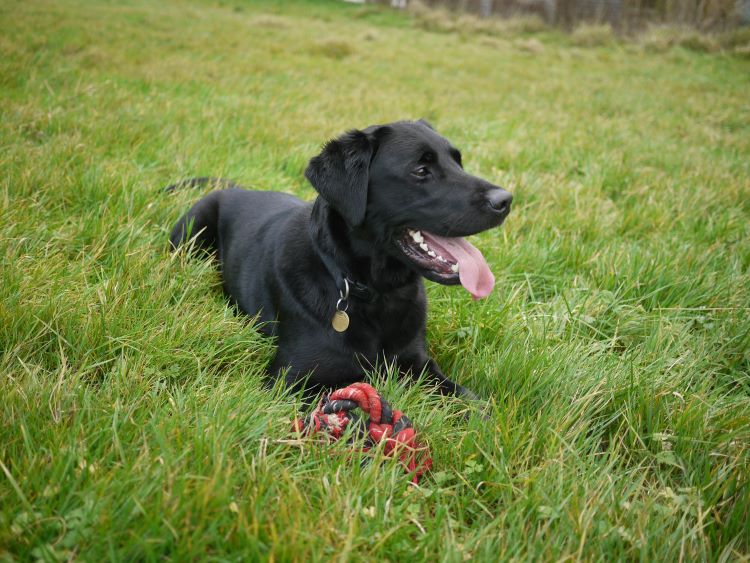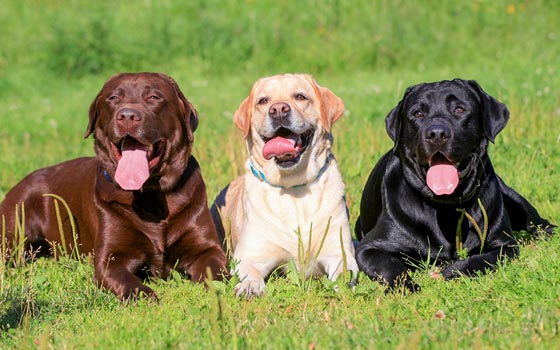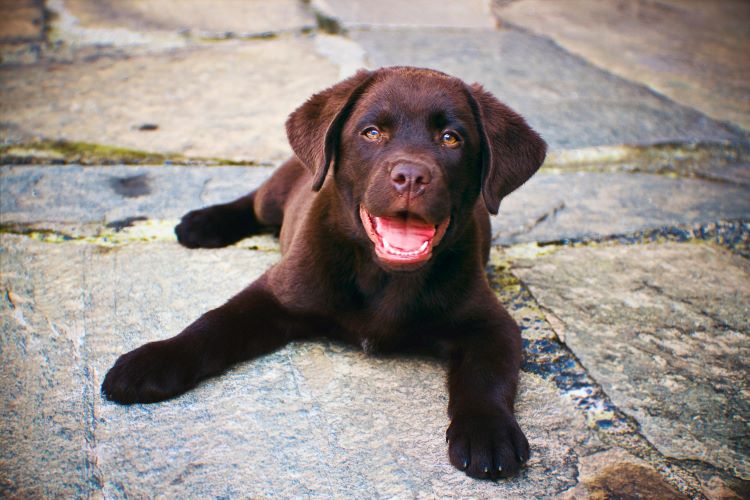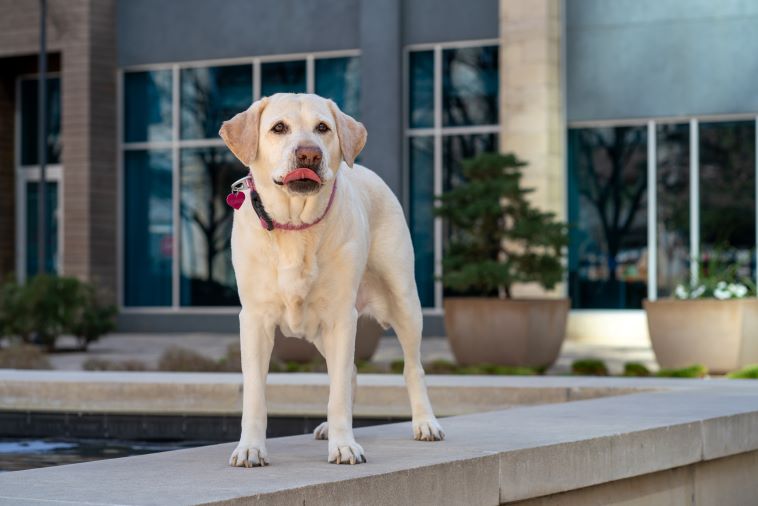Ready to help treat your pet to a healthy life?
Looking at the Labrador Retriever: a Dog Breed Guide
By : Trupanion Staff | Updated Jul 25, 2024

Ah, the Labrador Retriever. What's not to love about them? Easily one of the most popular and friendly pups of all time, the Lab is a prevalent sight in the pet world. Like all dog breeds, however, there's so much more to them than meets the eye. Considering adopting one of your own or just interested in learning more about what makes these dogs unique? From fun facts and breeding history to health and care tips, this Labrador Retriever breed guide is here to answer all your questions and provide deeper insight into these beloved canines.
8 fun facts about Labrador Retrievers
- They're medium-sized dogs, weighing between 50 and 80 lbs. (22 - 36 kg) when full grown. Life expectancy typically falls between 10 and 12 years.
- They're excellent swimming dogs, thanks to webbed paws and an otter-like tail.
- Labradors have an incredible sense of smell as well. This makes them ideal for search-and-rescue missions, detection of drugs, explosives, and even medical conditions like diabetes and certain cancers.
- They're popular! Labs have consistently been one of the most popular dog breeds among pet owners, beloved for their friendly, outgoing, and high-spirited personalities. They are often ranked as the number one breed by the American Kennel Club.
- Although the Canadian province of Newfoundland and Labrador consists of both the island of Newfoundland and mainland Labrador, the Labrador Retriever is a descendant of water dogs imported from Newfoundland, not Labrador.
- Labs are used to create the designer breed Goldadors (also called Glabs), a cross between two similar breeds, Labradors and Golden Retrievers.
- They’re eco-friendly! A Lab named "Tubby" snagged a Guinness World Record for the most plastic bottles recycled by a dog. He helped recycle an estimated 26,000 bottles by picking them up on his walks, crushing and giving them to his owner.
- Labrs are known for their "soft mouths." This trait was bred into them to allow them to retrieve game like ducks without damaging it. They can carry an egg in their mouths without breaking it!
Physical characteristics
Labrador Retrievers are known for their broad, blocky heads. As mentioned above they also have “otter” tails that act as a rudder and, believe it or not, webbing between their toes, making them adept swimmers.
This breed comes in a variety of shapes, sizes, and colors. There can be a wide range of shades within these colors, from light cream to fox red in yellows, and varying depths of chocolate and black.
- Black — The most common color, black Labradors have a solid black coat. Occasionally, they may have a small white patch on their chest or a few white hairs on their paws.
- Yellow — Yellow Labradors can vary widely in shade, from pale cream to fox red. The color can sometimes be uneven, with lighter or darker areas on the coat.
- Chocolate — Chocolate Labradors range from light to dark brown. The depth of the chocolate color can vary, with some having a more reddish or liver tone.
You might even see all three colors in one litter of puppies! Yellow labs go a step further, with variations from a pale cream to a darker “red fox” color. There’s even what’s called a “silver” Lab, but this is not an official or recognized color of the breed – occurring due to a genetic mutation of chocolate Labs.

While these are the standard colors recognized by major kennel clubs, Labradors may also have subtle variations within these categories, but only black, yellow, and chocolate are accepted in official breed standards.
While we're discussing appearances, it's also worth noting there are technically two “styles” of Labrador Retriever: English show Labs and American field Labs. American field Labs are bred to be more energetic and agile, with longer limbs and a narrower head. On the other hand, English show Labs have a stockier build, with blocky heads, shorter legs, and a broader chest. Both are the same breed, but due to geographical breeding for certain qualities, there tend to be more field Labs in America and more show Labs in the United Kingdom. And don’t let the labels fool you — both styles can be sporting or show dogs.
Personality and temperament
We all know at least one goofy Labrador! It’s one of their most lovable characteristics. As a breed, they’re just plain happy. They live life to the fullest as loyal, friendly dogs, eager to please. They also have big brains and love to use them. These qualities, combined with a tremendous willingness to work, make them great support animals. You’ll see Labs doing search and rescue, working as guide dogs for the blind, and a host of other amazing support roles.
Similar dog breeds
- Chesapeake Bay Retriever
- Nova Scotia Duck Tolling Retriever
- Curly-Coated Retriever
- Flat-Coated Retriever
- Golden Retriever
History of the Labrador Retriever
Labs have a long and interesting history. They are descendants of the St. John’s dog, traced back to the early settlers of the island of Newfoundland in the 1500s. They remained in Canada until the early 1800s when the Earl of Malmesbury reportedly saw them working in the water, retrieving fish tossed from boats. He snatched up a few and brought them back to England; sure they’d make perfect sporting companions and waterfowl retrievers. Over the years, they were crossbred with a variety of breeds, threatening to dilute the original breed lines permanently.
But how did we get from the St. John’s dog to the lovable Labs we have today? It’s all thanks to the Duke of Beccleuch’s breeding kennel in Scotland. The Earl of Malmesbury sent the Duke some of his St. John’s dogs in 1885. Duke Beccleuch tried to keep the bloodlines pure, even importing a few of the last Canadian purebreds in the 1930s for his breeding program. Sadly, the St. John’s dog was extinct by the 1980s, when the last known purebred pair passed away.
North American history of the Lab
The good news is, we have an amazing dog in the modern-day Labrador Retriever, recognized as an official breed by the Kennel Club in England in 1903 and the American Kennel Club in 1917.
In 1991 the Labrador Retriever became the most popular dog breed in the United States, based on AKC registrations. It held this position all the way until 2022, when it was finally surpassed by the French Bulldog. The Lab nevertheless continues to be one of the most popular pups in the country as well as the world.

Behavior and training
Labrador Retrievers were originally bred as waterfowl retrievers but have found their place in a variety of roles. They make wonderful family pets, can keep up with an active family, and love being a part of an adventure. Often described as goofy and ready-for-anything, they make a great teammate and companion for running, hiking, a day at the lake. They thrive in an environment with regular, dedicated training.
Do Labradors play well with others?
While Labs are known as a very social breed, proper proactive exposure to new sights, sounds, people, dogs, and other animals as a young puppy is essential for their socialization skills.
Labs do well with children and can enjoy the companionship of other animals in the home as long as they’ve been properly introduced and socialized from puppyhood. Young children and dogs should always be supervised, and it’s helpful for a dog to have their own “safe space” where they can go when they need some quiet time.
Trainer tip
Pair meeting new people or animals with high-value training treats or a favorite toy, and keep introductions short and sweet, so it doesn’t get overwhelming.
Exercise requirements
Labs are an energetic breed needing lots of daily exercise. If left to their own devices, they will follow their noses, happy to eat anything they find (including your couch!).
Speak with your veterinarian about appropriate exercise for a Lab puppy. Until they are full-grown (bone growth plates typically all close by around 1 year of age), avoid strenuous or repetitive activities like jogging or running — as this can increase their risk of damage to the growing bone and cartilage, causing pain and future joint issues.
Veterinarian tip
While a tired dog might be a good dog, puppy exercise shouldn’t be forced or “pushed” in any way. Follow your puppy’s lead in the amount of activity they are able to do. If they stop and sit down, it’s time for some rest and recovery. In some cases, they might try to “keep up” with an adult dog, so make sure not to let them push too far and over-exercise themselves.
Mental enrichment needs
Mental enrichment is essential to keep this intelligent breed entertained and their brains sharp. Puzzle bowls and interactive toys are a great way to keep them engaged and slow down their eating, as Labs can be quite voracious kibble vacuums at mealtime! (This may also help prevent bloat or GDV, a dangerous health emergency.)
Working a Lab’s nose is a great way to provide mental enrichment. Consider taking long, sniff-focused walks in different environments or enrolling in nosework or tracking classes.
Common behavioral issues
Labs are an exuberant breed and love new faces. As a result, they sometimes need training around greeting people and animals politely. Work with a positive reinforcement trainer to teach them to stand or sit patiently when saying hi to new people.
As mentioned previously, Labs are also known to eat any and everything. Teaching a solid Leave It or Drop It helps keep them safe and prevent them from inhaling food or other items that might be unsafe or cause gastrointestinal issues, such as foreign body obstruction. They really will eat the craziest things, from golf balls to even pocketknives.
Fun activities for the Labrador Retriever
Beyond basic training and socialization, Labrador Retrievers excel in a variety of dog sports and activities, including:
- Dock Diving
- Hunting
- Trail Hiking
- Therapy Work
- Agility
- Rally Obedience

Grooming and health care
Labs have a double-coat with a water-repellent undercoat and smooth topcoat — and boy, do they shed!
While you may have heard the Labrador Retriever’s colors coincide with different temperaments or personalities, science has yet to prove this. However, some links between certain health issues and life expectancy based on color within the breed have been found. Though more research needs to be done, this is likely the result of irresponsible breeding practices in some circles.
Labrador Retrievers need a minimum of weekly brushing and occasional baths. While they shed year-round, there is an uptick in shedding twice a year, usually in the spring and fall, as their coat changes for either summer or winter weather. Introduce your Lab puppy to the grooming experience from a young age to create a positive association that will make future grooming easy.
Best brush for Labrador Retrievers: Slicker brush, undercoat rake, Pin brush
Lab health risks
As with all dog breeds, Labs are prone to some health conditions more than others. The good news is that the Labrador Retriever is considered a health dog breed overall. The Lab's gene pool has become quite expansive over the years, which means a diverse array of genes that can help protect the dogs from being overly susceptible to genetic disorders and certain illnesses.
Commonly seen health conditions in Labrador Retrievers include the following:
- Hip and elbow dysplasia
- Cardiovascular issues
- Luxating patella
- Canine cataracts
- Ear infections
Labs in pop culture
These wonderful dogs are popular across society! From the homes of the rich and famous to being canine movie stars and performing good deeds, Labs are well-deserving of acclaim
Famous owners of the Labrador Retriever
- Cristiano Ronaldo (Soccer Player)
- Sarah McLachlan (Musician)
- Steve Martin (Actor)
- King Charles (British Monarch)
- Donna Karan (Fashion Designer)
- Miranda Lambert (Musician)
- Arnold Schwarzenegger (Actor, Former Governor)
- Bill Clinton (Former President)
- Kevin Costner (Actor)
Labrador Retrievers in books, movies and TV
Thanks to their trainability and versatility, Labs have frequently appeared in a huge assortment of entertainment media. Here's just a few examples:
- Luath in The Incredible Journey
- Marley from Marley & Me (the book as well as the 2008 film adaptation)
- Buddy (and other dogs) from the Air Bud franchise
Other famous Labs
Jake was a courageous black lab who served as a search and rescue dog from 2001 to 2006. He is known for his heroic efforts as a rescue dog following both the September 11 attacks and Hurricane Katrina. He also worked as a therapy dog at nursing homes in Utah as well as at a center for burn victims.
